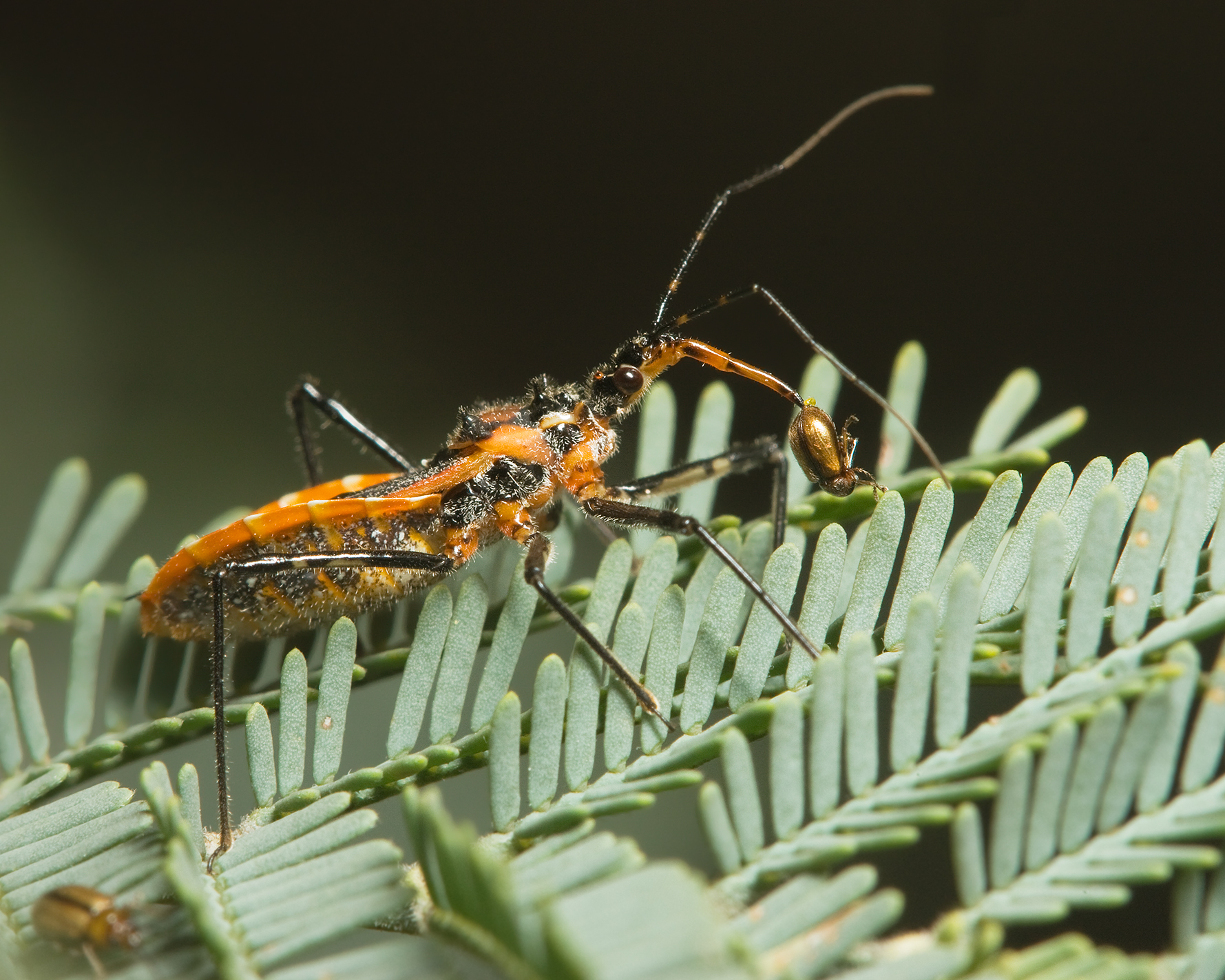|
Stenopodainae
The Stenopodainae are a subfamily of Reduviidae (assassin bugs). Many species of this subfamily are endemic to tropical rainforests, and some smear their fore legs with sticky, plant-derived resin, to aid in prey capture. Genera These 22 genera belong to the subfamily Stenopodainae: * '' Apronius'' Stål * '' Aulacogenia'' Stål, 1870 * ''Bardesanes'' Distant, 1909 * '' Canthesancus'' Amyot and Serville, 1843 * ''Caunus'' Stål, 1865 * '' Ctenotrachelus'' Stål, 1868 * '' Diaditus'' Stål, 1859 * '' Duriocoris'' Miller, 1940 * '' Gnathobleda'' Stål, 1859 * '' Hemisastrapada'' Livingstone and Ravichandran, 1988 * '' Kumaonocoris'' Miller 1952 * '' Narvesus'' Stål, 1859 * '' Neoklugia'' Distant 1919 * '' Neothodelmus'' Distant 1919 * '' Oncocephalus'' Klug, 1830 * '' Pnirontis'' Stål, 1859 * '' Pygolampis'' Germar, 1825 * '' Sastrapada'' Amyot and Serville, 1843 * '' Staccia'' Stål, 1865 * '' Stenopoda'' Laporte, 1832 * '' Streptophorocoris'' Miller 1957 * '' Thodelmus ... [...More Info...] [...Related Items...] OR: [Wikipedia] [Google] [Baidu] |
Apronius
''Apronius'' is a genus within the subfamily Stenopodainae of Reduviidae. Five species are known, most from South America. Partial list of species *''Apronius froeschneri'' *''Apronius granulosus'' References {{Taxonbar, from=Q4782131 Reduviidae Hemiptera of South America ... [...More Info...] [...Related Items...] OR: [Wikipedia] [Google] [Baidu] |
Duriocoris
''Duriocoris'' is a genus within the subfamily Stenopodainae of Reduviidae. 3 species are known from China China, officially the People's Republic of China (PRC), is a country in East Asia. It is the world's most populous country, with a population exceeding 1.4 billion, slightly ahead of India. China spans the equivalent of five time zones and .... Partial list of species *'' Duriocoris geniculatus'' 2005 References {{Taxonbar, from=Q5316649 Reduviidae Hemiptera of Asia ... [...More Info...] [...Related Items...] OR: [Wikipedia] [Google] [Baidu] |
Aulacogenia
''Aulacogenia'' is a genus within the subfamily Stenopodainae of Reduviidae. 19 species have been described, including 5 from China China, officially the People's Republic of China (PRC), is a country in East Asia. It is the world's most populous country, with a population exceeding 1.4 billion, slightly ahead of India. China spans the equivalent of five time zones and .... Partial list of species *'' Aulacogenia corniculata'' Stål *'' Aulacogenia zhangi'' Wang, 2008 References {{Taxonbar, from=Q4821690 Reduviidae Endemic fauna of China ... [...More Info...] [...Related Items...] OR: [Wikipedia] [Google] [Baidu] |
Assassin Bug
The Reduviidae are a large cosmopolitan family of the order Hemiptera (true bugs). Among the Hemiptera and together with the Nabidae almost all species are terrestrial ambush predators: most other predatory Hemiptera are aquatic. The main examples of nonpredatory Reduviidae are some blood-sucking ectoparasites in the subfamily Triatominae. Though spectacular exceptions are known, most members of the family are fairly easily recognizable; they have a relatively narrow neck, sturdy build, and a formidable curved proboscis (sometimes called a rostrum). Large specimens should be handled with caution, if at all, because they sometimes defend themselves with a very painful stab from the proboscis. Taxonomy The Reduviidae are members of the suborder Heteroptera of the order Hemiptera. The family members are almost all predatory, except for a few blood-sucking species, some of which are important as disease vectors. About 7000 species have been described, in more than 20 recognized subfa ... [...More Info...] [...Related Items...] OR: [Wikipedia] [Google] [Baidu] |
Reduviidae
The Reduviidae are a large cosmopolitan family of the order Hemiptera (true bugs). Among the Hemiptera and together with the Nabidae almost all species are terrestrial ambush predators: most other predatory Hemiptera are aquatic. The main examples of nonpredatory Reduviidae are some blood-sucking ectoparasites in the subfamily Triatominae. Though spectacular exceptions are known, most members of the family are fairly easily recognizable; they have a relatively narrow neck, sturdy build, and a formidable curved proboscis (sometimes called a rostrum). Large specimens should be handled with caution, if at all, because they sometimes defend themselves with a very painful stab from the proboscis. Taxonomy The Reduviidae are members of the suborder Heteroptera of the order Hemiptera. The family members are almost all predatory, except for a few blood-sucking species, some of which are important as disease vectors. About 7000 species have been described, in more than 20 recognized subfa ... [...More Info...] [...Related Items...] OR: [Wikipedia] [Google] [Baidu] |
Pygolampis
''Pygolampis'' is a genus of assassin bugs in the family Reduviidae. Five species have been described from Vietnam, and at least eleven worldwide. species * '' Pygolampis angusta'' Hsiao, 1977 * '' Pygolampis bidentata'' (Goeze, 1778) * '' Pygolampis blandus'' Jacquelin du Val * '' Pygolampis foeda'' Stål, 1859 * '' Pygolampis matogrossensis'' Costa Lima & Campos Seabra, 1945 * '' Pygolampis pectoralis'' (Say, 1832) * '' Pygolampis rufescens'' Hsiao, 1977 * '' Pygolampis sericea'' Stål, 1859 * '' Pygolampis simulipes'' Hsiao, 1977 * '' Pygolampis spurca'' Stål, 1859 * '' Pygolampis tuberosa'' 2003 v Data sources: i = ITIS, c = Catalogue of Life, g = GBIF, b = Bugguide.net v = Vietnam References {{Taxonbar, from=Q7263035 Reduviidae Fauna of Vietnam ... [...More Info...] [...Related Items...] OR: [Wikipedia] [Google] [Baidu] |
Pnirontis
''Pnirontis'' is a genus of assassin bugs in the family Reduviidae. There are more than 30 described species in ''Pnirontis''. Species These 37 species belong to the genus ''Pnirontis'': * '' Pnirontis acuminata'' Barber, 1929 * '' Pnirontis barberi'' Hussey, 1954 * '' Pnirontis beieri'' Wygodzinsky, 1948 * '' Pnirontis bellatrix'' Hussey, 1954 * '' Pnirontis brevispina'' Barber, 1929 * '' Pnirontis brimleyi'' Blatchley, 1926 * '' Pnirontis buenoi'' (Lima & Seabra, 1945) * '' Pnirontis demerarae'' Haviland, 1931 * '' Pnirontis edentula'' (Berg, 1879) * '' Pnirontis elongata'' Barber, 1929 * '' Pnirontis filiformis'' (Walker, 1873) * '' Pnirontis grandis'' Maldonado, 1994-01 * '' Pnirontis granulosa'' Barber, 1930 * '' Pnirontis grisea'' Barber, 1929 * '' Pnirontis guggiarii'' Hussey, 1954 * '' Pnirontis heminigra'' Maldonado, 1986 * '' Pnirontis incerta'' Reuter, 1887 * '' Pnirontis infirma'' Stål, 1859 * '' Pnirontis inobtrusa'' Barber, 1929 * '' Pnirontis languida'' Stål, ... [...More Info...] [...Related Items...] OR: [Wikipedia] [Google] [Baidu] |




